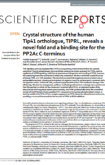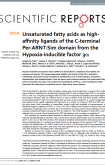Highlights
Publications
-
Crystal structure of the human Tip41 orthologue, TIPRL, reveals a novel fold and a binding site for the PP2Ac C-terminus
| DOI: 10.1038/srep30813
Abstract: TOR signaling pathway regulator-like (TIPRL) is a regulatory protein which inhibits the catalytic subunits of Type 2A phosphatases. Several cellular contexts have been proposed for TIPRL, such as regulation of mTOR signaling, inhibition of apoptosis and biogenesis and recycling of PP2A, however, the underlying molecular mechanism is still poorly understood. We have solved the crystal structure of human TIPRL at 2.15 Å resolution. The structure is a novel fold organized around a central core of antiparallel beta-sheet, showing an N-terminal α/β region at one of its surfaces and a conserved cleft at the opposite surface. Inside this cleft, we found a peptide derived from TEV-mediated cleavage of the affinity tag. We show by mutagenesis, pulldown and hydrogen/deuterium exchange mass spectrometry that this peptide is a mimic for the conserved C-terminal tail of PP2A, an important region of the phosphatase which regulates holoenzyme assembly, and TIPRL preferentially binds the unmodified version of the PP2A-tail mimetic peptide DYFL compared to its tyrosine-phosphorylated version. A docking model of the TIPRL-PP2Ac complex suggests that TIPRL blocks the phosphatase’s active site, providing a structural framework for the function of TIPRL in PP2A inhibition.
Full text: http://www.nature.com/articles/srep30813
-
Unsaturated fatty acids as high-affinity ligands of the C-terminal Per-ARNT-Sim domain from the Hypoxia-inducible factor 3α
Author(s): Angela M. Fala, Juliana F. Oliveira, Douglas Adamoski, Juliana A. Aricetti, Marilia M. Dias, Marcio V. B. Dias, Maurício L. Sforça, Paulo S. Lopes-de-Oliveira, Silvana A. Rocco, Camila Caldana, Sandra M. G. Dias & Andre L. B. Ambrosio | Source: Scientific Reports | DOI: 10.1038/srep12698 | Published: August 3rd
Full text: http://www.nature.com/articles/srep12698
-
Structure of a bacterial α2-macroglobulin reveals mimicry of eukaryotic innate immunity
Author(s): Steve G. Wong & Andréa Dessen | Source: Nature Communications 5, Article number: 4917 | DOI: 10.1038/ncomms5917 | Published: 15 September 2014
Abstract: http://www.nature.com/ncomms/2014/140915/ncomms5917/abs/ncomms5917.html
-
A Redox 2-Cys Mechanism Regulates the Catalytic Activity of Divergent Cyclophilins
Author(s): Campos, BM.; Sforça, ML.; Ambrosio, ALB.; Domingues, MN.; Souza, TACB.; Barbosa, JARG.; Paes Leme, AF.; Perez, CA.; Whittaker, SB.;Murakami, MT.;Zeri, ACM.; Benedetti, CE. | Source: Plant Physiology, 2013, v.162, p.1311-1323. | DOI: http://dx.doi.org/10.1104/pp.113.218339 | Published: May 2013
Abstract: The citrus (Citrus sinensis) cyclophilin CsCyp is a target of the Xanthomonas citri transcription activator-like effector PthA, required to elicit cankers on citrus. CsCyp binds the citrus thioredoxin CsTdx and the carboxyl-terminal domain of RNA polymerase II and is a divergent cyclophilin that carries the additional loop KSGKPLH, invariable cysteine (Cys) residues Cys-40 and Cys-168, and the conserved glutamate (Glu) Glu-83. Despite the suggested roles in ATP and metal binding, the functions of these unique structural elements remain unknown. Here, we show that the conserved Cys residues form a disulfide bond that inactivates the enzyme, whereas Glu-83, which belongs to the catalytic loop and is also critical for enzyme activity, is anchored to the divergent loop to maintain the active site open. In addition, we demonstrate that Cys-40 and Cys-168 are required for the interaction with CsTdx and that CsCyp binds the citrus carboxyl-terminal domain of RNA polymerase II YSPSAP repeat. Our data support a model where formation of the Cys-40-Cys-168 disulfide bond induces a conformational change that disrupts the interaction of the divergent and catalytic loops, via Glu-83, causing the active site to close. This suggests a new type of allosteric regulation in divergent cyclophilins, involving disulfide bond formation and a loop-displacement mechanism.
Full text: http://www.plantphysiol.org/content/162/3/1311.full
-
Identification of novel interaction between ADAM17 and thioredoxin-1
Author(s): Aragão, A.Z.B.; Nogueira, M.L.C.; Granato, D.C.; Simabuco, F.M.; Honorato, R.V.; Hoffman, Z.; Yokoo, S.; Laurindo, F.R.M.; Squina, F.M.; Zeri, A.C.M.; Oliveira, P.S.L.; Sherman, N.E.; Paes Leme, A. F. | Source: The Journal of Biological Chemistry, 2012, v.287, p.40371-43082. | DOI: 10.1074/jbc.M112.364513
Abstract: ADAM17, which is also known as TNFα-converting enzyme, is the major sheddase for the EGF receptor ligands and is considered to be one of the main proteases responsible for the ectodomain shedding of surface proteins. How a membrane-anchored proteinase with an extracellular catalytic domain can be activated by inside-out regulation is not completely understood. We characterized thioredoxin-1 (Trx-1) as a partner of the ADAM17 cytoplasmic domain that could be involved in the regulation of ADAM17 activity. We induced the overexpression of the ADAM17 cytoplasmic domain in HEK293 cells, and ligands able to bind this domain were identified by MS after protein immunoprecipitation. Trx-1 was also validated as a ligand of the ADAM17 cytoplasmic domain and full-length ADAM17 recombinant proteins by immunoblotting, immunolocalization, and solid phase binding assay. In addition, using nuclear magnetic resonance, it was shown in vitro that the titration of the ADAM17 cytoplasmic domain promotes changes in the conformation of Trx-1. The MS analysis of the cross-linked complexes showed cross-linking between the two proteins by lysine residues. To further evaluate the functional role of Trx-1, we used a heparin-binding EGF shedding cell model and observed that the overexpression of Trx-1 in HEK293 cells could decrease the activity of ADAM17, activated by either phorbol 12-myristate 13-acetate or EGF. This study identifies Trx-1 as a novel interaction partner of the ADAM17 cytoplasmic domain and suggests that Trx-1 is a potential candidate that could be involved in ADAM17 activity regulation.
Full text: http://www.jbc.org/content/287/51/43071.abstract?sid=a0aa5454-ba8b-461e-b108-434f8f70c233
-
Glutaminase C as key for the metabolism of cancer cells
Author(s): Cassago, A., Ferreira, A. P. S., Ferreira, I. M., Fornezeri, C., Gomes, E. R. M., Greene, K. S., Pereira, H. M., Garratt, R. C., Dias, S. M. G., Ambrosio, A. L. B. | E-mail: andre.ambrosio@lnbio.org.br | Source: Proceedings of the National Academy of Sciences of the United States of America, 2012, v. 109, p.1092-1097. | DOI: 10.1073/pnas.1112495109 | Published: 6 January 2012
Full text: http://www.pnas.org/content/early/2012/01/05/1112495109.full.pdf+html
-
Microbiology: Sensing stability
Author(s): Neves, D.; Dessen, A. | E-mail: andrea.dessen@lnbio.org.br | Source: Nature Chemical Biology, 2012, v.8, n.8, p.681-682 | DOI: 10.1038/nchembio.1026 | Published: 18 July 2012
Full text: http://www.nature.com/nchembio/journal/v8/n8/full/nchembio.1026.html
-
Molecular Cloning and Characterization of a Sphingomyelinase D from Loxosceles adelaida, a Brazilian Brown Spider from Karstic Areas
Author(s): Queiroz, G. P.; Gonçalves-de-Andrade, R. M.; Okamoto, C. K.; Sobreira, T. J.; Oliveira, P. S. L.; Murakami, M. T.; Berg, C.; Tambourgi, D. V. | E-mail: mario.murakami@lnbio.org.br | Source: Toxicon, 2012, v.60, n.2, p.230-231. | DOI: - | Published: August, 2012
Full text: http://www.sciencedirect.com/science/article/pii/S0041010112003601
-
Observations on the therapeutic practices of riverine communities of the Unini River, AM, Brazil
Author(s): Santos J de F, Pagani E, Ramos J, Rodrigues E. | E-mail: eduardo.pagani@lnbio.org.br | Source: Journal of Ethnopharmacology, 2012, v.142, n.2, p.503-515. | DOI: - | Published: 30 May 2012
Full text: http://www.sciencedirect.com/science/article/pii/S0378874112003376
-
Proteomic analysis of matrix of dental biofilm formed under dietary carbohydrate exposure.
Author(s): Moi, G.P., Dombroski, T.C.D., Pauletti, B.A., Cury, J.A., Paes Leme, A.F. | E-mail: adriana.paesleme@lnbio.org.br | Source: Caries Research, 2012, v. 46, n.4, p. 339-345 | DOI: 10.1159/000338246 | Published: 17 May 2012


